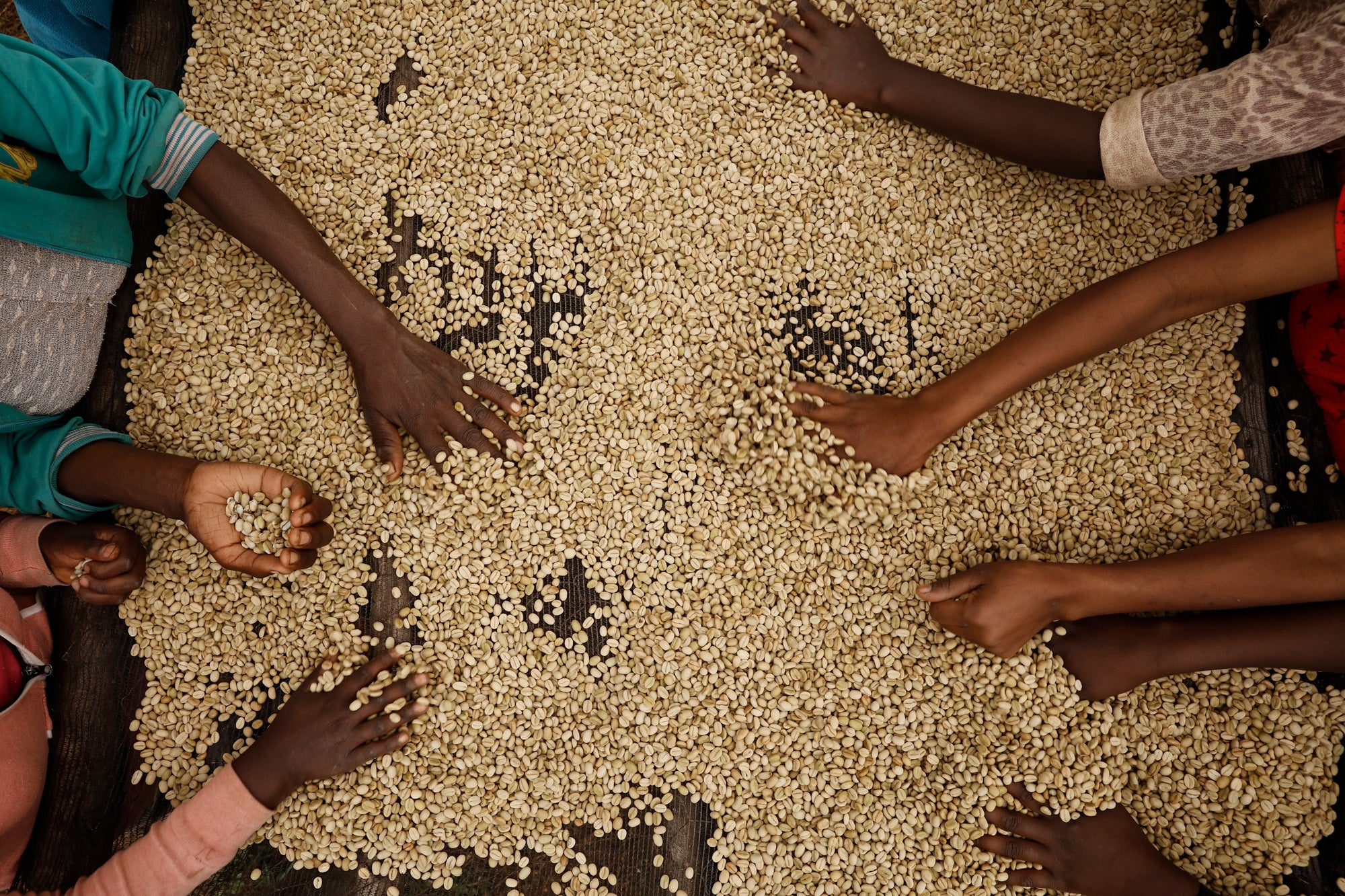Finca Licho, Villa Sarchí, Costa Rica 2018
This taste profile is very typical to Costa Rican coffee. A coffee that is as complex as a blend on its own. Now we haven’t blended since 2010, but this coffee is a text book example for killing the argument to blend for flavour aspects. Juicy medium body, honey sweet, bakers’ chocolate and a long vibrant citric aftertaste. You got it! And the people behind it are quite special too. It is not only one producer, but 12 siblings (!) running Finca Licho.
Visiting Finca Licho
Drop Coffee has visited the Finca Licho two times. The first time was in 2017, after cupping the coffee at the exporter we are working with in Costa Rica's lab. Arriving at Licho on the driveway, we were met by almost all of the 12 siblings running the farm. It was a lot of Spanish speaking and everyone talking and describing the farm, and a lot of motorcycles. The second thing that struck me was the football field at a flatten out bit of the slopes of the farm. During the busy time of the season, there is no time for playing, and the field is covered by drying tables for the coffee. Besides mopeds, the football and motorcycles I was very impressed by the coffee plant nursery at Licho. We dived into discussions of climate change, resistant varietals and cup quality. Where the Villa Sarchi varietal is a good combination of both at Finca Licho.
The second time we visited, in January 2018, it had been raining all day, but just as we arrived at the farm there was a massive rainbow, and so the saga began for us and here is the coffee!
About the producers - the Aguilera siblings
The Aguileras are 12 brothers and sisters, all of whom are involved in coffee as inherited from their parents. The brothers work the mill and farms themselves with basically no hired labour, other than pickers during the harvest. With the help of the third generation, they work the mill and drying patios, prune the coffee trees, fertilize, etc, year-round. The Aguilera Bros understand quality at the farm and mill level, and this is why we are excited about working with them.
About Costa Rica as a coffee producing country
In Costa Rica 93 percent of the children go to school and the country has no army. The supply chain of coffee in the country is more profitable than we meet in many other countries - speaking extremely generally.
The Typica beans arrived in Costa Rica in 1700, properly cultivated since 1779. Between 1800 to 1950 this was the main source of income for the country but went down after the 1980s. Today the main income is tourism, followed by technology, medical appliance, other agriculture and coffee in 8th place, turning over about 450 million USD (2017).
Currently, the regions producing the best quality are Tarrazu, West Valley, and Central Valley. Coffee production has been threatened the past decade due to a real-estate boom converting coffee-lands into prime development properties. San Jose, the capital, is right in the heart of Central Valley, where you will find private houses next to coffee farms. The value of these farms has now skyrocketed.
About the Villa Sarchi varietal
Grown by the Aguilera brothers in the province of Naranjo, in the volcanic Northern Cordiles corridor of the Western Valley, this coffee is cultivated at an altitude of 1,500 metres above sea level. Most of the coffee is of the Villa Sarchi variety, native to the area and excellent in the cup. Villa Sarchi is a Bourbon mutation (similar to Caturra and Pacas) found originally in Naranjo, West Valley. It is a dwarf variety with short internodes and usually higher-yielding production.
About the yellow honey processing
This coffee is honey processed, which is like the pulped natural method, so the fruit is removed from the seed of the coffee cherry and left to dry. The main difference is that there is no water involved when the cherry is removed, so mucilage sticks to the bean. This can be dangerous, but it's necessary for these parts of Costa Rica where water is limited: in this area of Naranjo water is a precious commodity, so this method suits the location very well and in general suits the cup profile in Costa Rica.
The coffee ends up clustering whilst drying because there is so much mucilage. So the coffee either needs to be turned regularly to stop this happening, or it has to be broken up. Over-fermentation can happen at this stage and you can end up with a not-so-good cup, but the Aguilera brothers are well-versed in this method and are some of the most skilled we have met in Costa Rica. The "Yellow" is describing how much of the mucilage is left on the bean while drying. If 15-50% is left on the colour of the beans are going towards the colour yellow as it dries.
SHORT FACTS ABOUT FINCA LICHO
Farm: Finca Licho
Producers: Aguilera siblings
Processing System: Yellow Honey
Varietal: 70% Villa Sarchí & 30% Caturra
Location: Western Valley area, in the Alajuela province. Nearest city: Naranjo de Alajuela
Farm Size: 28.00 Hectares
Coffee growing area: 9.10 Hectares
Altitude: 1,500 m.a.s.l.
Harvest period: January-February 2018
Taste profile: A bakers chocolate aroma and a sweetness of the honeydew melon. The yellow honey from Licho is a very juicy cup with notes of lychee, roasted hazelnuts and satsumas. Vibrant aftertaste of lime that lasts long after you have finished the sip, reminding a bit of sour beer - in a very good way!
Learn More
- Choosing a selection results in a full page refresh.
- Press the space key then arrow keys to make a selection.
